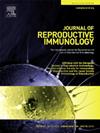Do progesterone receptor membrane components (PGRMC)s play a role in the chorions refractoriness to epithelial-to-mesenchymal transition (EMT)?
IF 2.9
3区 医学
Q3 IMMUNOLOGY
引用次数: 0
Abstract
Fetal membrane inflammation is one of the drivers of adverse pregnancy outcomes. One of the reported pathways of inflammation is epithelial-mesenchymal transition (EMT) of amniotic epithelial cells. EMT is resisted during gestation via signaling initiated by the binding of progesterone (P4) to progesterone receptor membrane components (PGRMC1/PGRMC2). The vulnerability of chorionic trophoblast cells (CTCs) to transition has not been studied. Here, we examined CTCs EMT in response to the stressors and the role of PGRMC1/PGRMC2. CTCs were treated with the autophagy inhibitor bafilomycin (Baf), transforming growth factor beta (TGF-β, EMT-inducer), and lipopolysaccharide (LPS) to simulate cellular stressors associated with an adverse pregnancy environment. The primary endpoints included morphological evidence of EMT, N-cadherin-to-E-cadherin ratio, vimentin/cytokeratin staining, pro-inflammatory cytokine and P4 production. PGRMC1/PGRMC2 knock-out (KO) CTCs were prepared using CRISPR/Cas9, and experiments were repeated to test the influence of the P4–PGRMC axis. Wild-type CTCs were resistant to cellular transitions, changes in P4 production, and shifts in the inflammatory status under normal, LPS, or TGF-β conditions. Autophagy inhibition tended to cause CTCs to transition (morphological changes; high N-cadherin-to-E-cadherin ratio [p < 0.05], no change in vimentin/cytokeratin), though a complete transition was not evident. Further, neither PGRMC1/PGRMC2 played a role in CTC cellular transitions, as their KO did not cause any major changes. Chorion cells resist EMT to minimize inflammation and to maintain their barrier functions regardless of the presence of PGRMC1/ PGRMC2. Cellular stressors or infectious antigens are likely to impact the amnion, where membrane weakening can be initiated.
孕激素受体膜组分(PGRMC)是否在绒毛膜对上皮-间质转化(EMT)的难治性中起作用?
胎膜炎症是不良妊娠结局的驱动因素之一。羊膜上皮细胞的上皮-间质转化(EMT)是报道的炎症途径之一。孕激素(P4)与孕激素受体膜组分(PGRMC1/PGRMC2)结合后,EMT在妊娠期间受到抑制。绒毛膜滋养细胞(CTCs)的易变性尚未被研究。在这里,我们研究了ctc对应激源的EMT反应以及PGRMC1/PGRMC2的作用。用自噬抑制剂巴菲霉素(Baf)、转化生长因子β (TGF-β, emt诱导剂)和脂多糖(LPS)处理ctc,模拟与不良妊娠环境相关的细胞应激源。主要终点包括EMT形态学证据、n-钙粘蛋白与e -钙粘蛋白比值、vimentin/细胞角蛋白染色、促炎细胞因子和P4生成。利用CRISPR/Cas9技术制备PGRMC1/PGRMC2敲除(KO) ctc,重复实验检测P4-PGRMC轴的影响。在正常、LPS或TGF-β条件下,野生型ctc对细胞转变、P4产生的变化和炎症状态的变化具有抗性。自噬抑制倾向于引起ctc的形态转变;高n-钙粘蛋白与e -钙粘蛋白比值[p <; 0.05],波形蛋白/细胞角蛋白没有变化),但完全转变不明显。此外,PGRMC1/PGRMC2在CTC细胞转变中都没有发挥作用,因为它们的KO没有引起任何重大变化。无论PGRMC1/ PGRMC2是否存在,绒毛膜细胞都能抵抗EMT以减少炎症并维持其屏障功能。细胞应激源或感染性抗原很可能影响羊膜,在那里膜削弱可以启动。
本文章由计算机程序翻译,如有差异,请以英文原文为准。
求助全文
约1分钟内获得全文
求助全文
来源期刊
CiteScore
6.30
自引率
5.90%
发文量
162
审稿时长
10.6 weeks
期刊介绍:
Affiliated with the European Society of Reproductive Immunology and with the International Society for Immunology of Reproduction
The aim of the Journal of Reproductive Immunology is to provide the critical forum for the dissemination of results from high quality research in all aspects of experimental, animal and clinical reproductive immunobiology.
This encompasses normal and pathological processes of:
* Male and Female Reproductive Tracts
* Gametogenesis and Embryogenesis
* Implantation and Placental Development
* Gestation and Parturition
* Mammary Gland and Lactation.

 求助内容:
求助内容: 应助结果提醒方式:
应助结果提醒方式:


